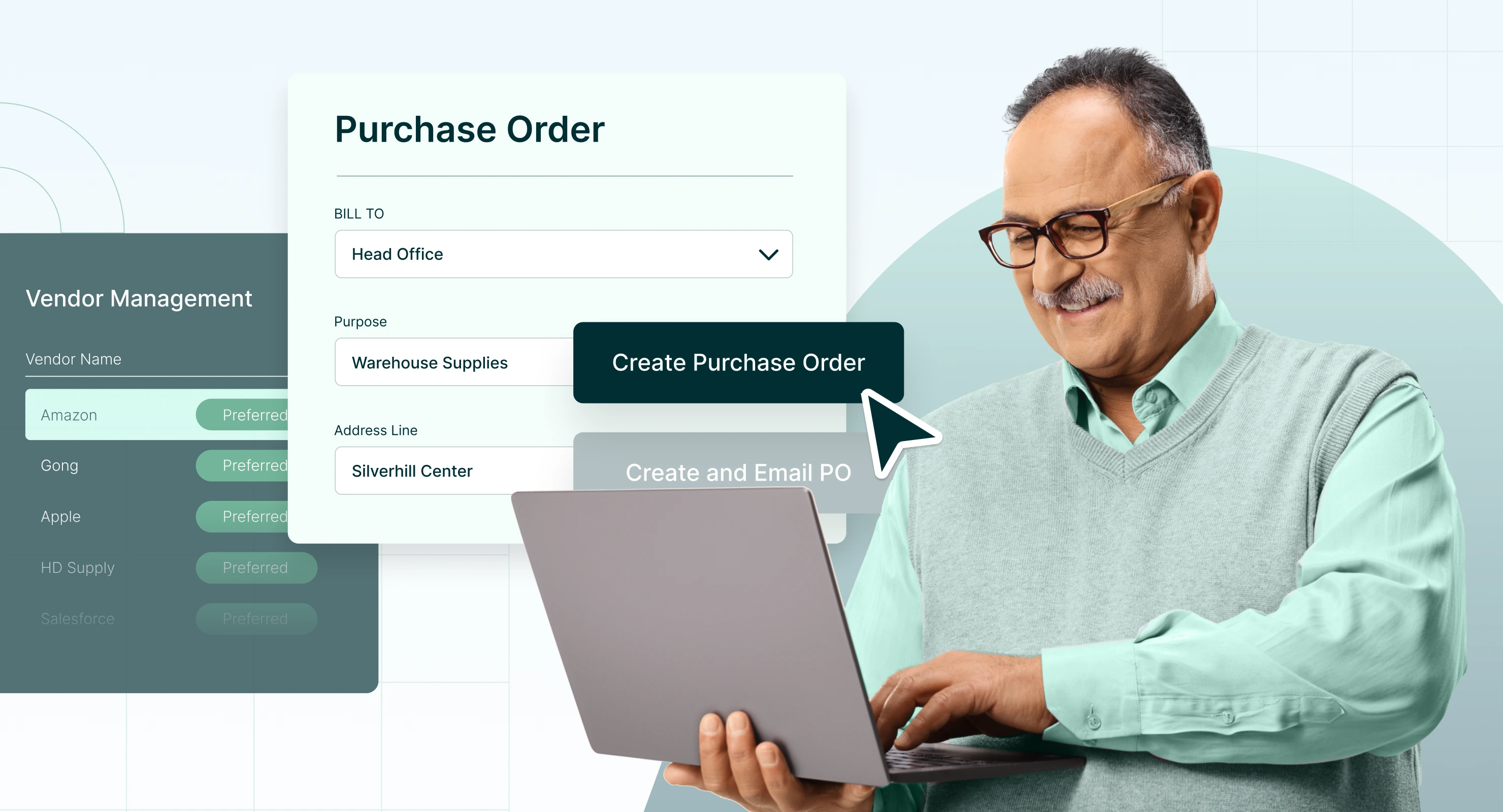
Procurement vs Purchasing: What’s the Difference?
Many people use the terms procurement and purchasing interchangeably. But despite their similarities, they do have different meanings. One focuses on transactional functions, for example, while the other focuses on the strategic process of product sourcing.
In this guide, we clarify any confusion on the difference between procurement vs purchasing, and deep dive into each area.
Before we begin
What is purchasing? the purchasing definition
In a business, purchasing is the act of acquiring a good or service and typically involves the immediate day-to-day transactions between sellers and buyers.
This often includes how a procurement manager goes about ordering and paying for something. For example, by creating and fulfilling purchase orders and arranging payment for goods.
The purchasing process involves:
- Spend requests and purchase approvals.
- Creation of a purchase order.
- Receiving and checking goods and services.
- Attaching a packing slip to a purchase.
- Passing the completed purchase to the accounts payable team.
What is procurement? The procurement definition
Procurement, on the other hand, is the process of sourcing and purchasing the goods and services a company needs to fulfill its business objectives, usually from an external source, like a third-party vendor or supplier.
An effective procurement strategy can do many things. For instance, it can save a company money by negotiating favorable terms and pricing. It can also ensure supplier quality, efficiency, and timeliness.
Often, procurement managers will procure goods and services with limited resources and reduced capabilities. This means they have to make the smartest possible choices to ensure they purchase the best goods and services.
Procurement managers deal with things like:
- Sourcing activities and tactical sourcing
- Negotiation and vendor management
- Strategically selecting goods and services
- Approving organizational purchase requests
- Receiving goods and services
In short, procurement generally involves making buying decisions under conditions of scarcity.
Read our detailed article on what is procurement.
What’s the difference between procurement and purchasing?
Good question. Essentially, you perform both procurement and purchasing when a company needs to acquire goods and services. But these two functions have different focuses and different methods for achieving their respective end goals.
Here’s a handy table that explains the differences between procurement and purchasing:
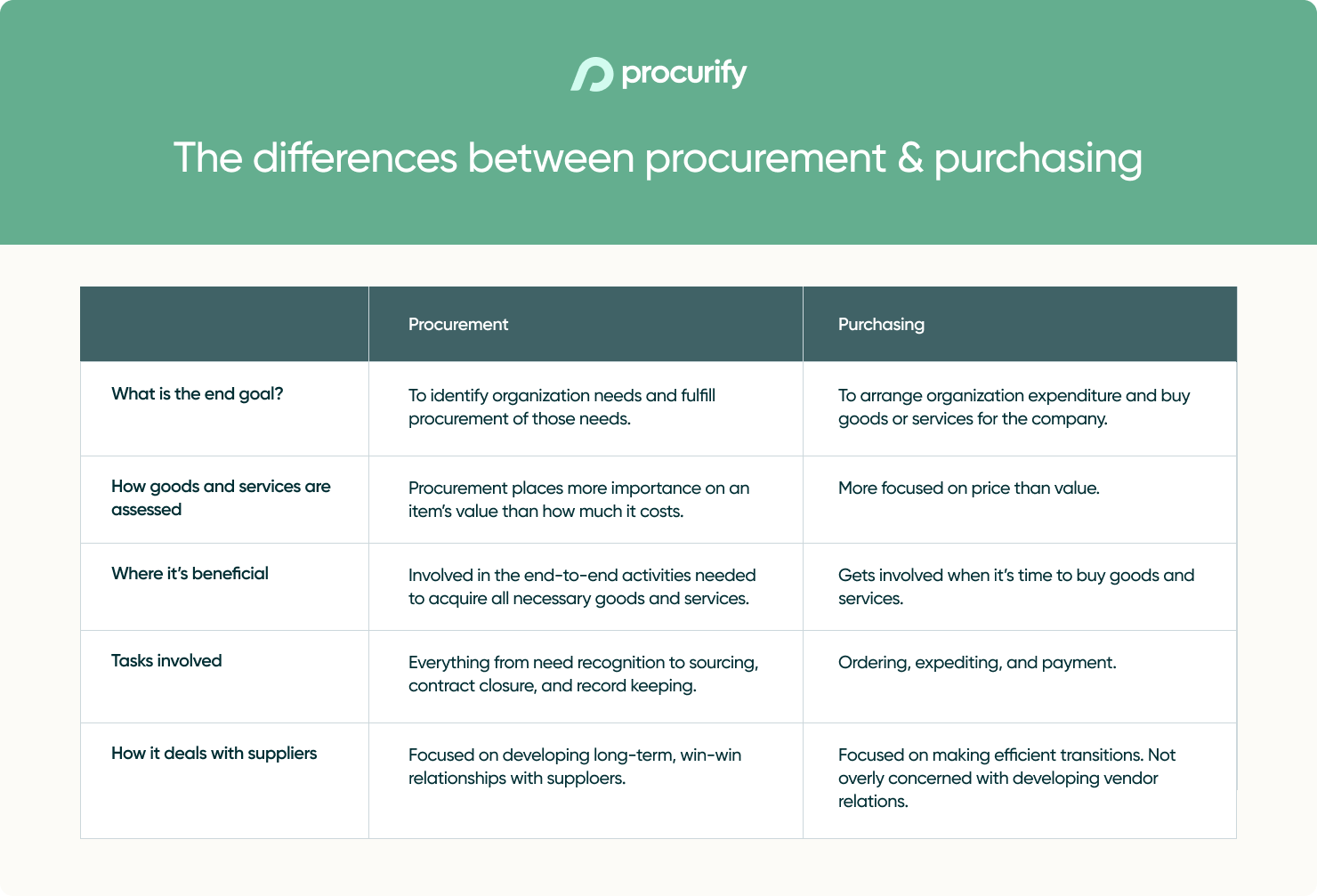
Purchasing is typically more focused on the short-term and is more transactional. It involves tasks such as ordering, raising purchase orders, receiving, and arranging payment. Purchasers are often looking to get items for the best price rather than the best overall value.
Procurement is a more long-term, holistic approach to acquiring goods and services for the business. It involves tasks such as sourcing vendors, negotiating and closing contracts, and record keeping. Unlike purchasing, procurement considers the overall value of the transaction, not just the price. It’s focused on building mutually beneficial relationships with suppliers.
Total cost of ownership: an important consideration
Total cost of ownership (TCO) and value creation is an important concept in procurement. TCO is the cost of the item plus the cost to operate it over its useful life. Instead of just looking at the price of an item, TCO factors in things like shipping, training, and maintenance. Procurement also considers other factors, such as risk mitigation, compliance, supplier relationships, and cost savings, when considering what vendors to buy from and do business with.
To summarize, purchasing focuses on short-term needs and cost minimization when purchasing goods and services and procurement focus on long-term value creation for the business.
Let’s take a closer look at the difference between procurement and purchasing and the roles that these two important functions play in business.
Steps in the procurement process
Procurement involves much more than just handing over the company credit card and paying for a purchase. For example, an effective procurement strategy includes everything involved in the procuring process, from identifying which goods and services an organization requires for growth, through to maintaining the right documentation and records.
The 10 steps of procurement
1. Identify the goods and services your organization needs
Determine which goods and services your organization needs to be productive and efficient.
2. Submit a purchase request
Submit a purchase request to your finance team. It’s important that finance team looks over all purchase requests to make sure that purchases are necessary and within budget.
3. Assess and select your vendors
Come up with a list of a few vendors you’d like to work with. Assess potential vendors based on factors such as price, quality, item availability, payment terms, and business operations and capabilities.
4. Negotiate price and terms
Once you’ve chosen a vendor you’d like to work with, negotiate the price and terms. Vendors may offer things like volume discounts, flexible payment plans, product warranties, or other services. You should work to reach a mutually beneficial agreement.
5. Create a purchase order
Create and submit a purchase order. Purchase orders outline the prices, quantities, and product specs for each item that you order. This is an important document so don’t lose it!
6. Wait for your order to arrive
Once your order has been prepared and shipped, all that’s left to do is wait for it to arrive.
7. Inspect and receive order
Once your order arrives, make sure to inspect it to make sure it’s the right product that you ordered and that the quality is good. If everything looks good, you can receive it in your system.
8. Conduct three-way matching
A three-way match is comparing the purchase order, the goods receipt, and the supplier’s invoice to make sure everything is correct and matches.
9. Approve the invoice and arrange payment
If everything looks good and the paperwork matches, you can approve the invoice and arrange payment to the vendor.
10. Conduct record keeping
Make sure all the paperwork (the purchase order, receipt, and invoice) are all properly stored and recorded for future reference.
Keep in mind, however, that how a company shapes its internal procurement process influences factors like the company’s size, industry, available human resources, and organizational structure.
For an in-depth explanation of the procurement process, check out our guide: Understanding the Procurement Process: A Comprehensive Guide?
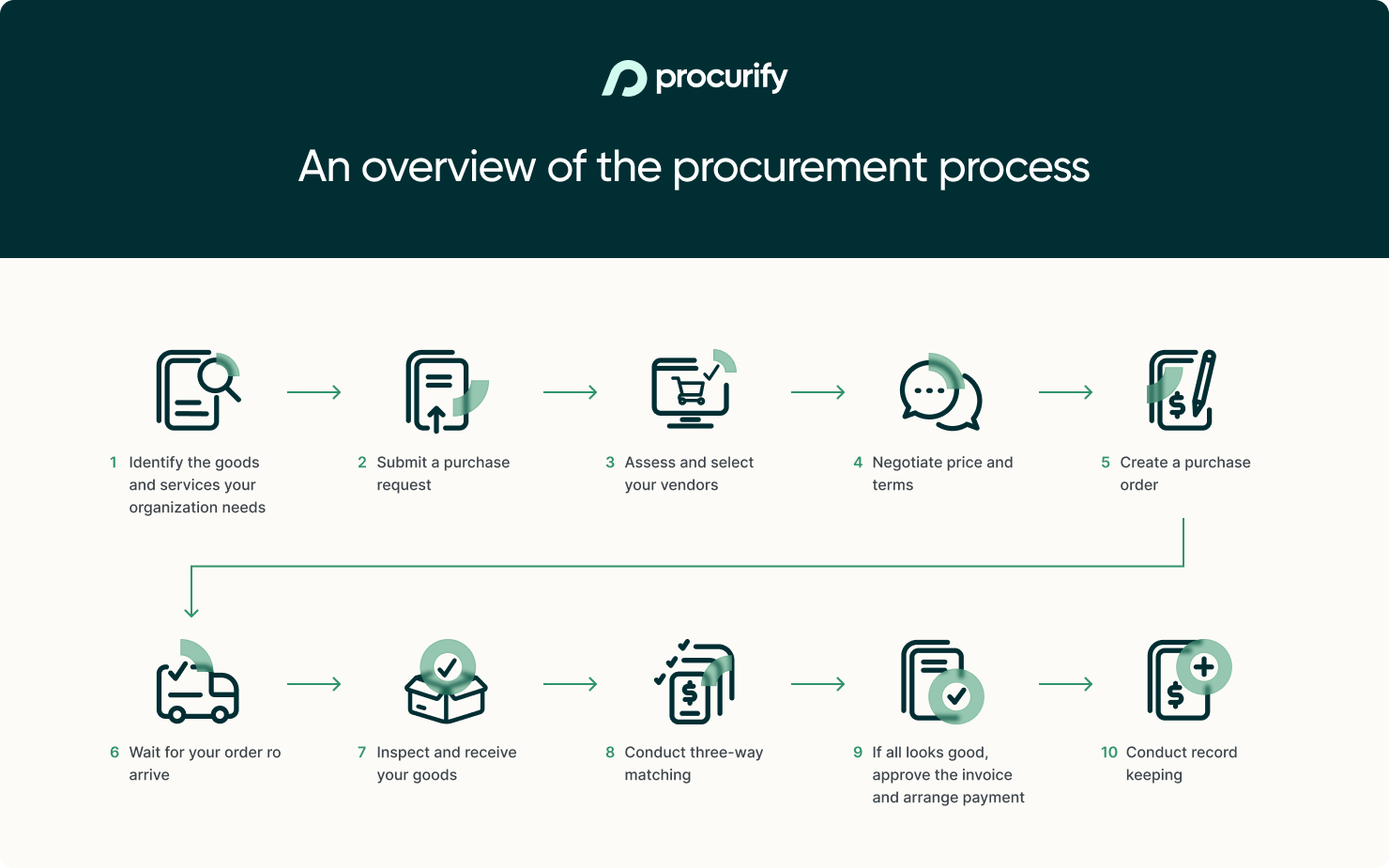
Why is procurement important in business?
Procurement is important in business because it directly impacts a company’s profit margin. For an organization to be profitable, the cost of procuring goods needs to be less than the amount it sells those goods for, minus whatever costs are associated with processing and selling them.
Enacting the best procurement procedures will ensure that the buyer (i.e. the company) is acquiring goods and services at the best possible price at all times.
In addition, procurement is linked to several core business functions within an organization. Therefore, it should always be considered a critical part of any organization’s corporate strategy.
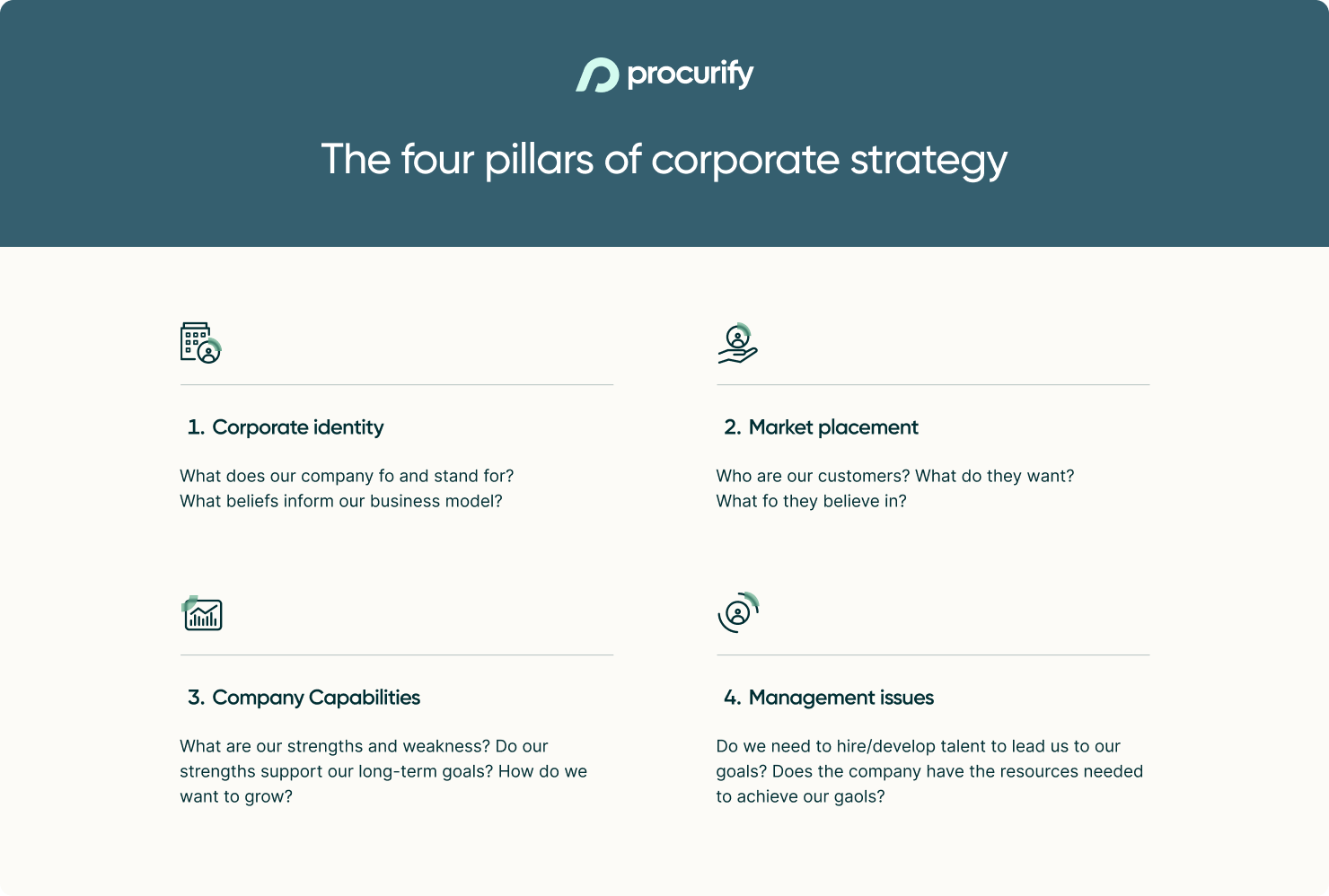
Procurement touches on each of these components.
Procurement in business: an example
For instance, procurement and corporate identity are intertwined. If your business is building (or has built) its identity around an environmentally conscious ethic, for example, then your procurement strategy should reflect this decision. However, for this to be successful, policies must be in place to ensure you are sourcing from companies with similar ethics, or that you are sourcing materials that are not environmentally hazardous.
A company’s procurement strategy should also be shaped with its market placement, company capabilities, and management issues in mind. It’s essential that a company has the right people in place to put into action the beliefs and philosophies you want to govern your business by. Handling vendor relationships, then, should reflect company philosophy.
What are the steps in the purchasing process?
As a function, purchasing is a subset of procurement. And as such, the purchasing process sits inside the procurement process.
However, unlike procurement-related tasks outlined above, you shouldn’t tailor the steps explicitly related to purchasing to suit the size and scope of each individual vendor you are purchasing from. This is a fundamental step of good purchasing and makes your process more streamlined. Ultimately, your purchasing process should employ routine best practices across all vendors.
The 6 steps of purchasing
1. Acknowledge your purchase order
Communicate that you have received the purchase order and confirm that all information, including prices, quantities, and items, is correct and ready for fulfilment
2. Send an advance shipping notice
Send an advance shipping notice (ASN) that provides all the details about the pending delivery. The ASN typically lists all the contents of the shipment and any additional details.
3. Collect and file your goods receipt
Once you have received your order, collect the receipt and file it properly with your other finance and accounting information.
4. Conduct invoice recording
Process and record your invoice with your financial information and records.
5. Perform a three-way match
Compare the purchase order, the goods receipt, and the supplier’s invoice to make sure everything is correct and matches.
6. Pay the vendor
If everything looks good, pay the vendor based on the agreed upon payment terms.
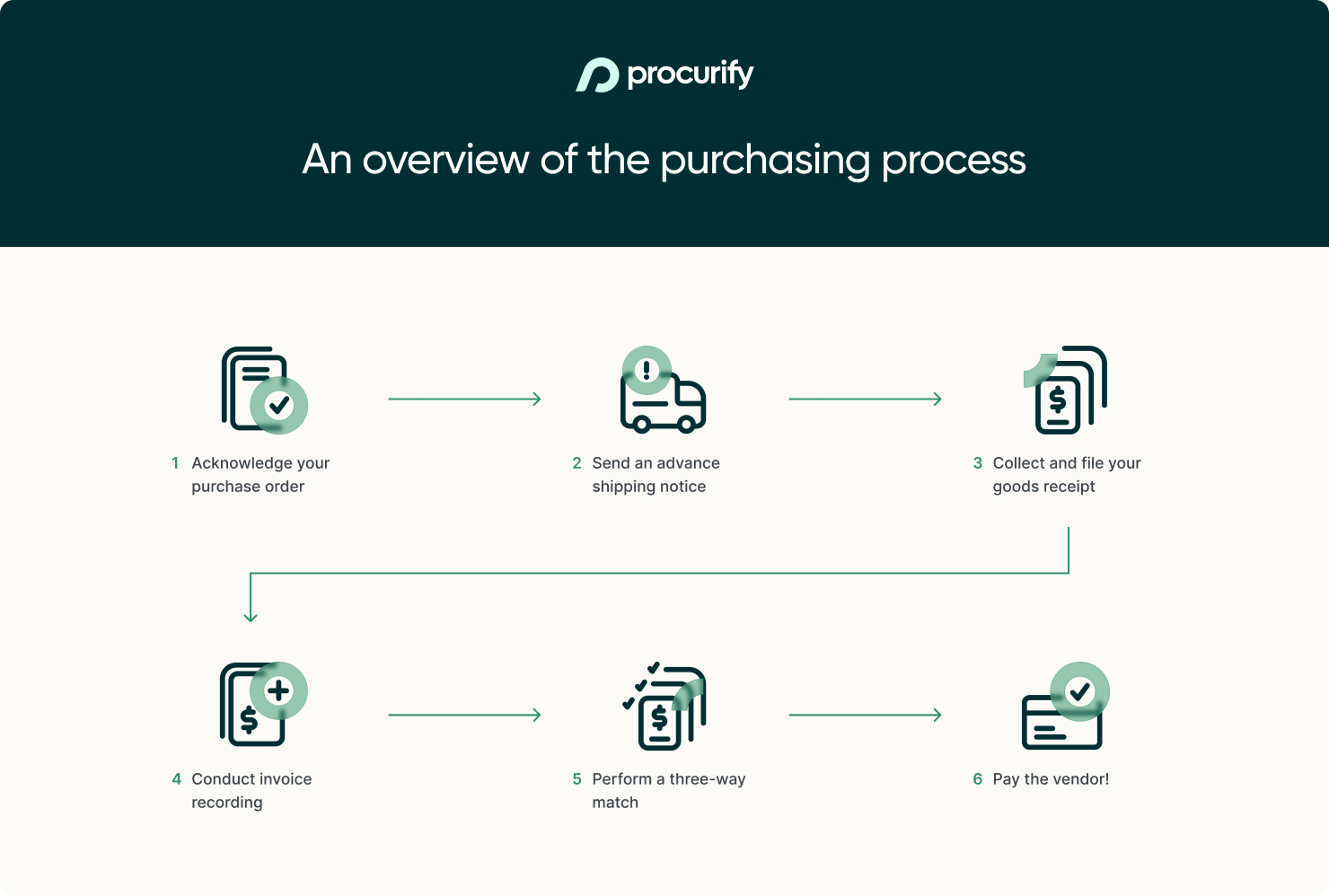
Automating your procurement and purchasing strategy with e-procurement
Procurement and purchasing both fall within an overarching process known as the procure-to-pay process. This cycle encompasses all of the steps a company must take to identify and acquire the goods and services it needs to do business. (In other words, it’s procurement and purchasing combined.)
To help you visualize how procurement and purchasing support one another throughout this cycle, here’s when these two functions get involved in the procure-to-pay cycle.
Procurement steps in the procure-to-pay cycle
- Identify goods and services required
- Approve purchase requests
- Procurement
- Identify suppliers
- Sending inquiries (RFQs and RFPs)
- Receipt of quotes from suppliers
- Negotiate pricing and terms
- Select vendors
Purchasing steps in the procure-to-pay cycle
- Acknowledge purchase orders
- Advance shipment notice
- Receive goods
- Inventory management
- Invoice recording
- Three-way match
- Payment to supplier
Automating procurement tasks and optimizing your procure-to-pay process with procure-to-pay software can have a significant impact on your company’s bottom line.
Procurement and expense management software platforms like Procurify can help your team better oversee all procurement and purchasing activities with features like:
- Purchase requesting functionality for everyone on the team
- Purchasing and procurement workflows
- Purchase order creation, approval, and storage
- Approved vendor catalogues that every team member can access online
- Approval systems based on locations, departments and dollar thresholds, that are easy for employees and procurement managers to follow
- A mobile app that helps you request, approve and receive goods on the go
- Vendor management and vendor performance tracking
- Three-way matching
- Data exporting into your accounting system
The efficiencies that procurement and purchasing software can bring to procurement strategy can eliminate overspending and yield huge savings (both time and money), regardless of the size of your organization.
How do you keep track of all purchasing activities
It’s important to keep track of your purchasing activities for your financial records and compliance purposes. The first thing to do is make sure that all the paperwork (purchase orders, receipts, invoices, and payment records) are all in one place. File everything properly and upload everything into your accounting software. This way you’ll know where everything is for future reference. Finally, you’ll also need to make sure that your accounting books and records are updated to reflect any recent purchases and payments.
Procurement and purchasing: an interchangeable relationship
Ultimately, purchasing is a process within the procurement process. Despite this, procurement and purchasing are oftentimes interchangeable. In the business world, the practice of using similar terminology in either conversation or printed materials is routine, although it is often confusing and should be avoided.
Procurement deals with the sourcing of activities, negotiation, and strategic selection of goods and services that are usually of importance to an organization. Purchasing, however, explains the process of ordering goods and services. In addition, purchasing also describes the transactional function of purchasing goods or services.
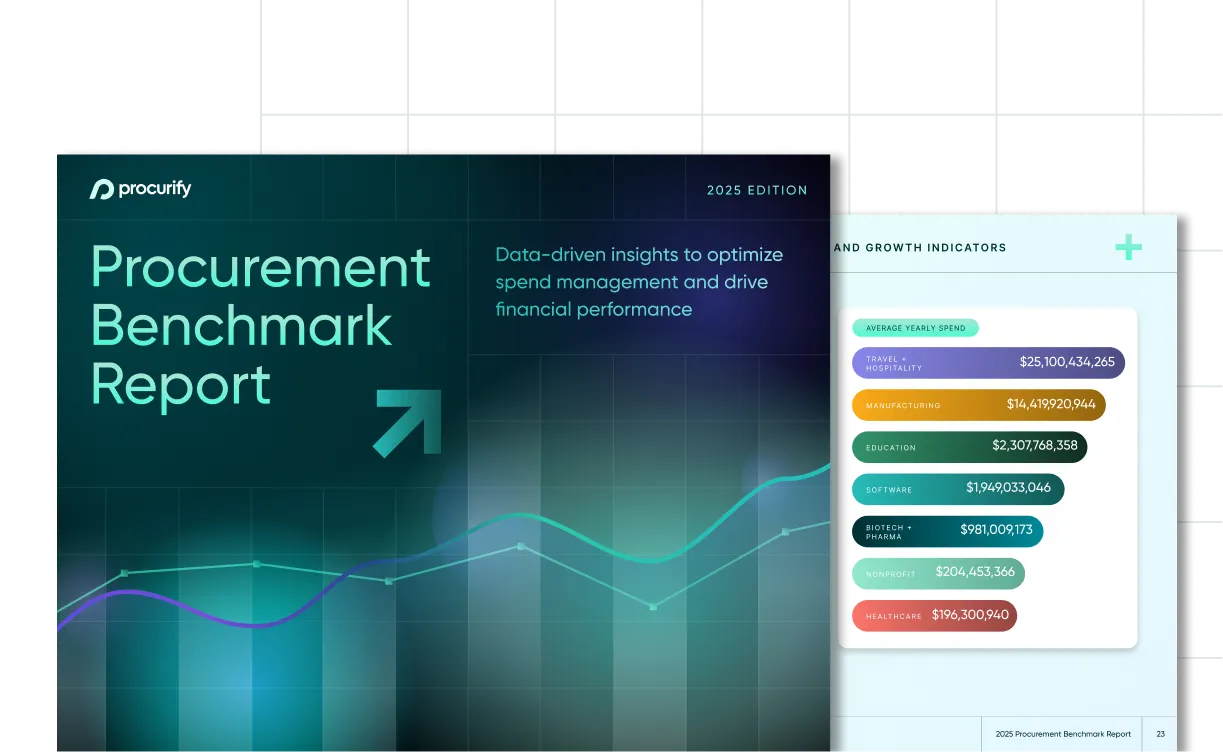
2025 Procurement Benchmark Report
Powered by $20B+ in proprietary data you won’t find anywhere else.

